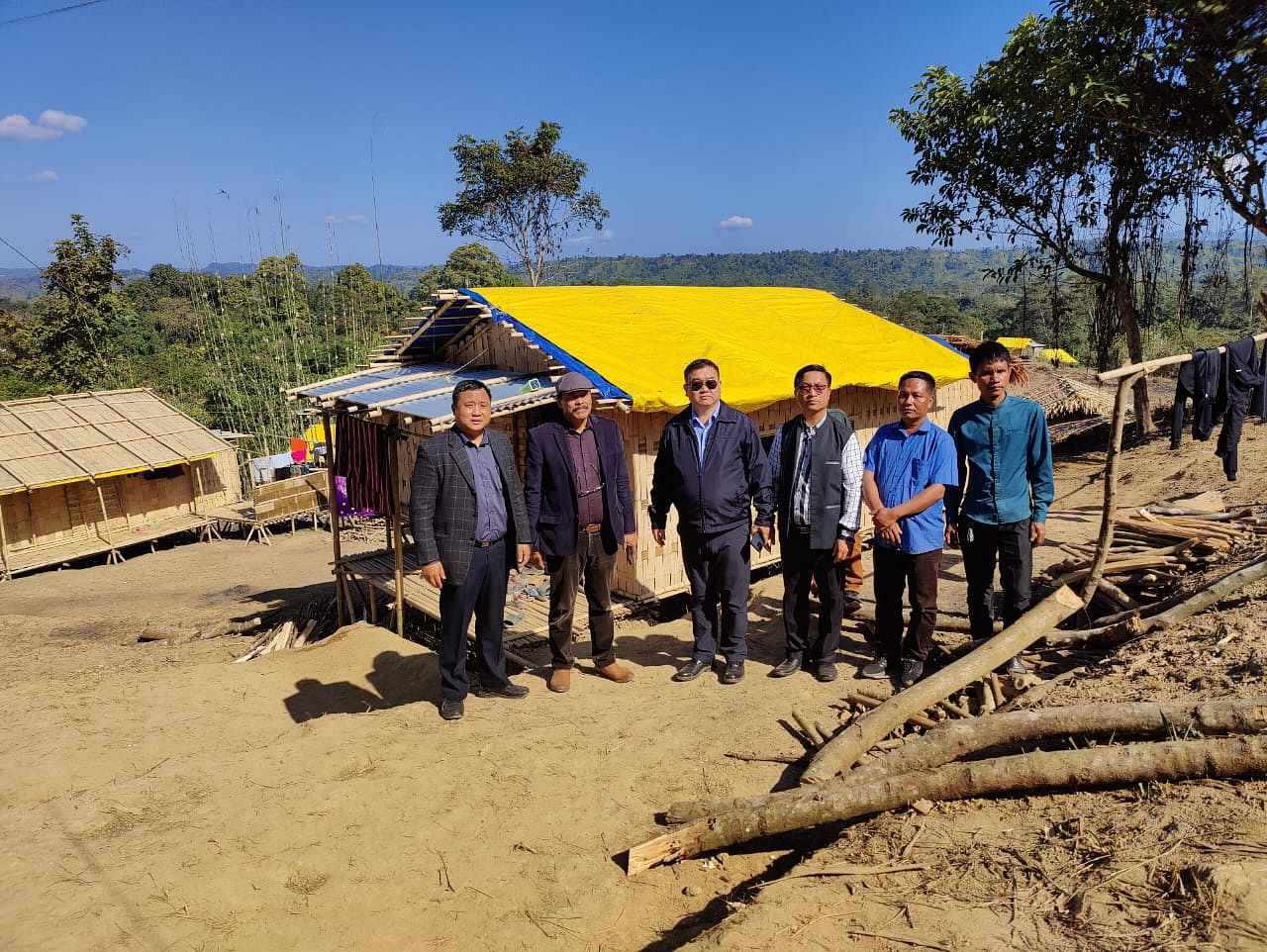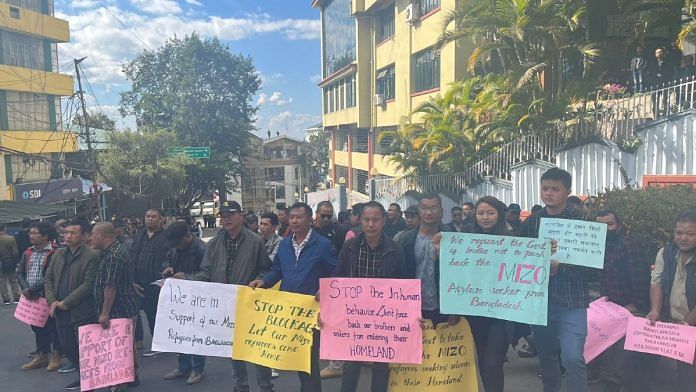Guwahati: A pick-up truck left the office of the Deputy Commissioner in Mizoram’s Lawngtlai district Tuesday evening for Parva-III village where 212 Kuki-Chin refugees from Chittagong Hill Tracts (CHT) in southeastern Bangladesh are taking shelter, informed a personnel under the Lawngtlai administration.
Depending on road conditions, it takes around 5-6 hours to reach the border villages from Lawngtlai. The pick-up truck was carrying tarpaulins, Damdawi (medicine), Thosilen (mosquito nets), grains and pulses, soaps, and blankets among other essentials for the Kuki-Chin refugees.

On Wednesday morning, Rural Development Minister Pu Lalruatkima visited Parva-III and distributed relief including food items, cooking oil, tea, and beverages.
The Kuki-Chin refugees, who share ethnic ties with the Mizos in India, recently fled a crackdown by Bangladesh on the Kuki-Chin National Army (KNA) which is fighting for an independent state in CHT. Most of the asylum seekers are from the Bawm tribe who primarily live in CHT’s Bandarban and Rangamati districts.
Mizoram has sanctioned a rehabilitation package of ₹30 lakh for 388 asylum seekers lodged at border villages of Parva III, Vanthuampui, Mautlang, Chamdur Project and Hmawngbu in Lawngtlai district.
According to government data, the refugees are from 108 families — 199 men and 189 women asylum seekers, including pregnant and lactating mothers, and 133 children.
Mizoram shares a 318-km-long border with Bangladesh and a 510-km-long border with Myanmar. Apart from those arriving from Bangladesh, the Northeastern state currently hosts “around 35,000-40,000 Chin refugees” from Myanmar who fled the Junta regime.
Also Read: Why Mizoram sees Myanmar refugees as ‘family’ — close ethnic ties that have survived a border
Mizo bodies appeal for restrain
On 4 January, an 81-year-old retired pastor, Sawmkhup, reportedly died of starvation in the deep jungles of the India-Bangladesh border. He was among the group of 600 asylum seekers “pushed back” into Bangladesh by the Border Security Force (BSF).
They were taking refuge in the forest for several days “without food and water”, read a statement from the Central Young Mizo Association (CYMA) in its letter addressed to the Union Home Ministry on 9 January.
The association is the largest non-political voluntary organisation of the Mizos with more than 4.7 lakh members from within and outside the state. It even has a branch in Bangladesh.
A solidarity demonstration was called by the CYMA at Aizawl Monday to protest against the death of the senior pastor. Carrying placards that read ‘Let our Mizo refugees come home’, ‘Stop the inhuman behaviour’, ‘Don’t force back our brothers and sisters from entering their homeland’, hundreds of demonstrators assembled outside the Raj Bhavan at Aizawl. A community donation of around ₹3lakh was collected for the asylum seekers during the demonstration.
A number of legislators from the ruling Mizo National Front (MNF) as well as opposition parties, including power and electricity minister R. Lalzirliana, sports minister Robert Romawia and the opposition Zoram People’s Movement (ZPM) leader Lalduhoma, took part in the protest, Mizoram Post reported.
“Whether they are from Bangladesh or Myanmar, if they are in need of help, the Mizos are willing to extend all possible assistance. There’s an old saying in the Mizo community — ‘if you have something to eat, you also need to share with others’. Our main motto is to help the needy. We don’t deprive any person in need on the basis of colour, religion or tribe,” CYMA general secretary Lalnuntluanga told ThePrint.
In its letter, the association urged the Centre to “look into the matter on humanitarian grounds” and to take urgent steps for providing safety and security, food, shelter and basic amenities to the asylum seekers “who have sought temporary refuge” in Mizoram.
“To die of starvation on being pushed back is an inhuman and insensitive act. On the night of 3 January, a pregnant lady had given birth in the jungle,” Lalnuntluanga claimed.
The Mizo Students’ Union (MSU) also raised concern for the safety of the refugees, alleging “mistreatment” by the BSF troops.
“They came without any weapons — just poor helpless civilians who sought safety in the lands of their neighbours. They were not even carrying food or any other belongings. With no help, they ate banana trunks to stay alive. Naturally, they are scared to return. We plead with the Indian government to resolve this issue, and let them enter Mizoram on compassionate, humanitarian grounds,” MSU president Samuel Zoramthanpuia said.
The waves of exodus
On November 20 last year, the first group of Kuki-Chin asylum seekers entered India through the border village of Parva in Lawngtlai. Lalnuntluanga said the group took almost five days to cross over — a strenuous route through deep forests and slopes.
The next day, 274 asylum seekers were handed over by the BSF to representatives of the Block Development Office at Chawngte rural development block in Lawngtlai, according to the CYMA representative.
Another 21 refugees moved in on 25 November, followed by 15 more on 7 December. According to the CYMA, inputs from local residents suggest at least 500 asylum seekers are currently taking refuge at Lawngtlai, much more than the government estimate.
On December 2, the BSF stopped a group of 117 refugees at Kamtuli village at the trijunction of India, Myanmar and Bangladesh. In November, the Mizoram Cabinet approved the setting up of temporary shelters with home minister Lalchamliana stating that the government sympathises with the refugees.
The government asked the village council at Lawngtlai to form a committee, enabling the relocation of around 50 refugee families from Parva III to the nearby villages. It also appointed an officer for enrolling and profiling each asylum refugee as per the existing rules under the central government.
These refugees are being taken care of of much like those from Myanmar, who entered Mizoram after fleeing the Junta during the February 2021 coup. “To earn livelihood, the Myanmarese refugees need to do something, but their children don’t have to worry about continuing education. We have admitted them to schools free of cost. Many NGOs are chipping in for relief. We have received funding from Mizos in the US, Canada, Australia, Europe etc. Donations are being collected for Bangladeshi and Myanmarese people,” said Lalnuntluanga.
Emergence of KNA in Bangladesh
Since Bangladesh gained independence in 1971, Chittagong Hill Tracts has seen the presence of various separatist groups, including the Jana Samhati Samiti (JSS), the United People’s Democratic Forum (UPDF), the Arakan Liberal Party and the Mog Party.
The KNA is an armed component of its political front, the Kuki-Chin National Front (KNF), locally known as ‘Bawm Party’. It emerged as a non-profit development body, the Kuki-Chin National Development Organisation (KNDO), in 2008, but evolved into a separatist group in 2017.
The KNF consists of members of six Kuki-Chin ethnic groups — Bawm, Pangkhua, Lusai, Khumi, Mro, and Khiang — from CHT. These tribes have lived for countless generations, often having cross marriages with their Indian counterparts in the border areas.
“Because of the Partition, and the Divide and Rule policy of the British, Mizos are scattered in Myanmar, Bangladesh, and other Northeastern states. But we have a bond. For Israelis across the world, Jerusalem is their main city. Similarly, for all the Mizos, wherever they are — their heart is very close and attached to Mizoram,” Lalnuntluanga remarked, while pointing out the Centre’s indifference to the refugee crisis.
In March 2021, the Centre noted that India is not a signatory to the 1951 UN Convention relating to the Status of Refugees and its 1967 Protocol. It, however, mentioned a Standard Operating Procedure issued in 2011 by the government and later amended in 2019, which is to be followed by law enforcement agencies while dealing with foreign nationals who claim to be refugees.
(Edited by Tony Rai)
Also Read: ‘They’re taking over our hills’: Manipur groups want NRC to weed out Myanmar refugees



